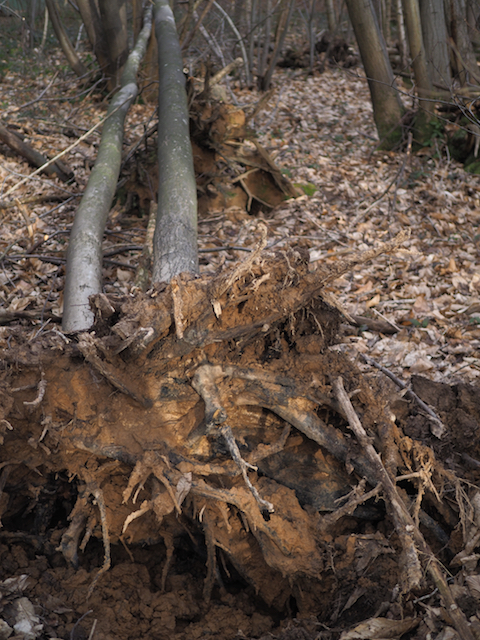Storm Ciara has done her thing bringing strong gusty winds and heavy rain - a grim weekend for weather. I am always a bit anxious that the wind will bring some trees down in Crow Wood, particularly as the ground is saturated and offers little anchorage for tall, wind-buffeted trees. So it was with a sense of relief to find most of the wood still standing and very little damage done. A tall Sweet chestnut had succumbed and fallen as had a rather fine Scots Pine in the recently cleared area. It may be that here the felling of surrounding trees had made it more vulnerable to the wind. It was one that we had deliberately left as it was a good specimen but all in vain as all 80' of it lies on the ground. In the hole where once its roots tried to hold fast, there is now a pond - the water table is so high.
It is notable how shallow both root plates are of these fallen trees. The soils are pretty impoverished sands and not far below is the greensand layer, so tree roots from both these species do not penetrate far into the ground. Our Redwoods must have a better system of anchorage as all 120' of Big Red has endured the 1987 hurricane and has shrugged off all that Ciara could throw at it. Living on the Pacific coast of Northern California has helped the species to evolve a way of securing themselves into the bed rock itself. In 1987 photographs of Ide Hill and surroundings after the storm showed a vista of completely flattened Beech and Oak Trees, amongst which the Redwoods were still standing proud.
I was very pleased to see a Marsh Tit on my last visit. They have been less frequent visitors to the bird feeders this winter. They are one of my favourite woodland birds and this one was very confiding.
 |
| The Sweet Chestnut root plate exposed |
 |
| The Scots pine felled by the wind |
 |
| the saturated ground and shallow roots offer little anchorage in high winds |
 |
| A very handsome Marsh Tit indeed |









Comments
Post a Comment
Thank you for your comments: